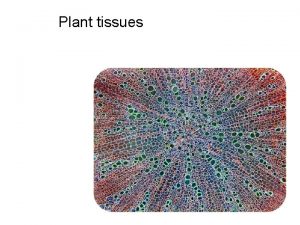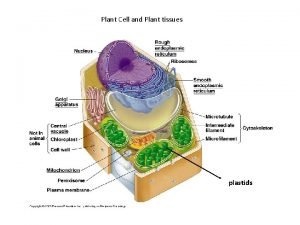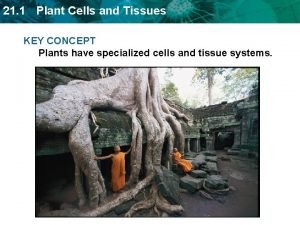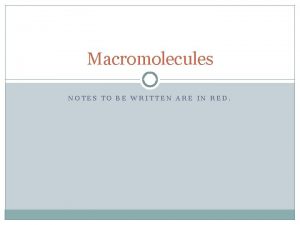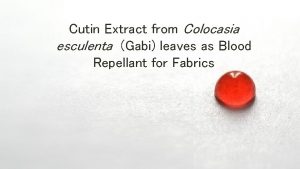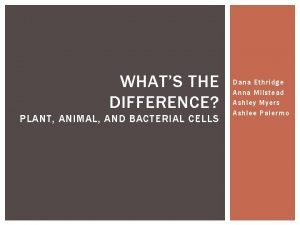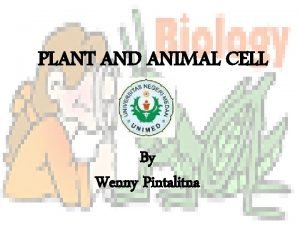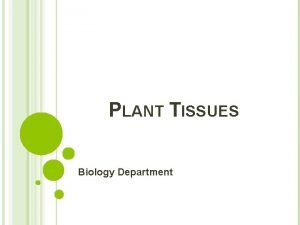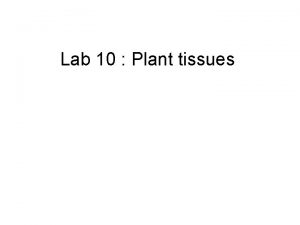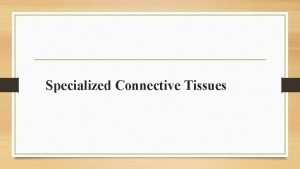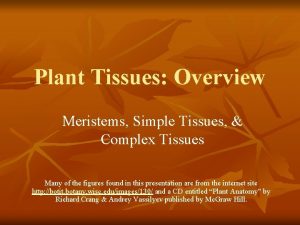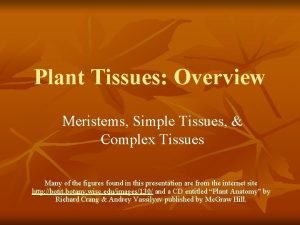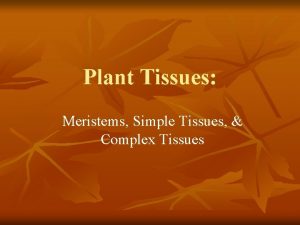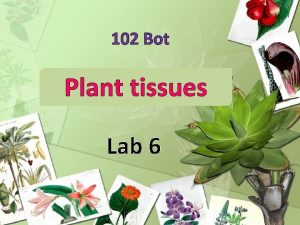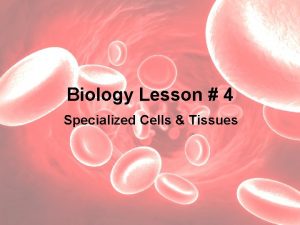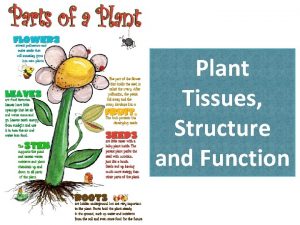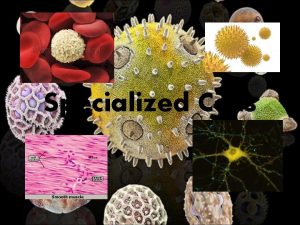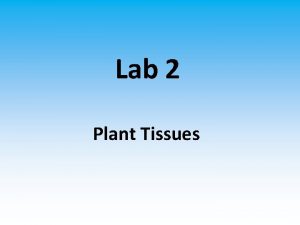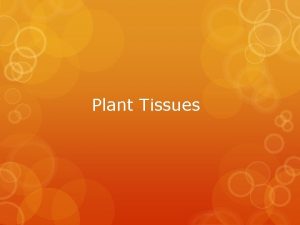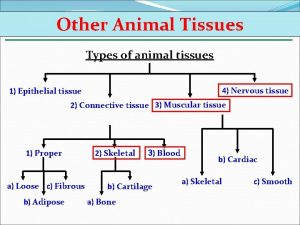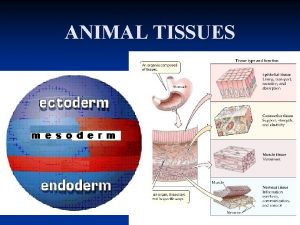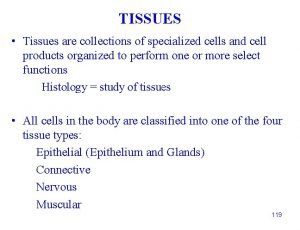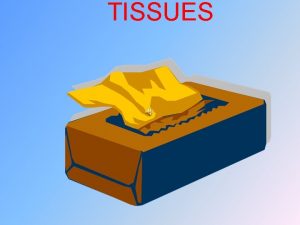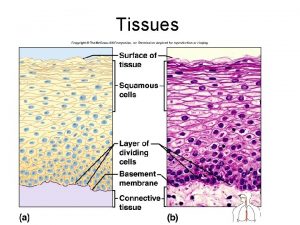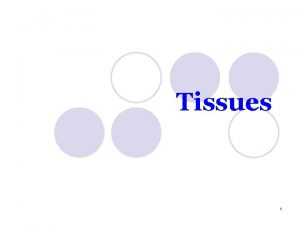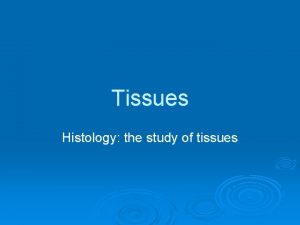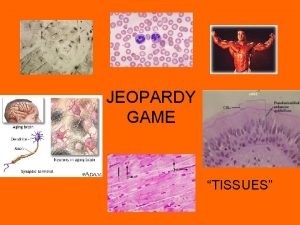Specialized Plant and Animal Tissues 2 Lesson 7

























- Slides: 25

Specialized Plant and Animal Tissues 2 Lesson 7 October 7 th, 2010

The Hierarchy of an Animal �When looking at an animal from its simplest level of organization to its most complex, it is referred to as its hierarchy. The structural organization with the most complex on top and the less important things below it. �Atoms < Molecules < Cells < Tissues < Organ System < Organism

The Hierarchy of an Animal Tissues: �Groups of similar cells that share the same specialized structure and function. Organs: �A combination of several types of tissues working together to perform a specific function. Organ system: �A system in which one or more organs and structures work together to perform a major vital body function such a digestion or

Types of Tissues in Animals (4)

Types of Tissues in Animals (4) 1. Epithelial Tissues �The main purpose of epithelial tissues is to protect the organism from dehydration while also providing a resistance to friction. These thin sheets of tightly packed cells cover surfaces such as skin as well as the lining of internal organs.

Types of Tissues in Animals (4) �Connective Tissue �The main purpose of connective tissues is to provide support and insulation. These cells and fibers are held together by a liquid, a solid or a gel, known as a matrix.

Types of Tissues in Animals (4) �Blood cells course through the body in a fluid matrix. Red blood cells contain hemoglobin, a protein that can absorb and release O 2. White blood cells protect the body from bacteria and viruses and fight infection. Platelets are cells that help in the process of blood clotting.

Types of Tissues in Animals (4) �In fibrous connective tissue, cells are scattered among the collagen fibers they secreted. In bone and cartilage, cells are scattered throughout the hard or pliable matrix.

3. Muscle Tissue �The main purpose of muscles tissues is to allow for the body to move. They are made of long, thin fibers that contain specialized proteins capable of shortening or contracting. �There are three types of muscle tissue

3. Muscle Tissue 1. Skeletal muscle cells are large, multinucleate, and column shaped cells; they are chiefly attached to the skeleton.

3. Muscle Tissue 2. Smooth muscle cells are small and mononucleate; they are found in the walls of tubes such as blood vessels, glandular ducts, and the digestive system

3. Muscle Tissue �Cardiac muscle cells of the heart are small, striated, and branched.

4. Nervous Tissue �The main purpose of nervous tissues is to provide sensory sensations which allow for communication with the brain which allow for the coordination of body functions (including reactions). These thin cells with fine branches at the ends are capable of conducting electrical impulses.

4. Nervous Tissue �Nervous tissues consist of the neurons themselves that transmit impulses and the cells that act as supporting connective tissue in the brain and spinal cord.

See Table in note for more information on tissues and summary

Plant Tissues (4) �All four types of plant tissue are grown from groups of meristematic cells known as meristematic tissue

1. Epidermal Tissue �The epidermal tissue on both the top and underside of the leaf is clear and very thin.

1. Epidermal Tissue �Specialized guard cells form a tiny opening, or pore, called a stomate, that allows carbon dioxide, water vapour, and oxygen to move into or out of the leaf easily. Most stomata are found on the underside of the leaf.

2. Vascular Tissue �Vascular tissue plays an important role in transporting water and nutrients throughout the plant.

2. Vascular Tissue There are two types of vascular tissue in the plant: Xylem is responsible for the movement of water and minerals from the roots up the stem to the leaves, where these substances are used in photosynthesis.

2. Vascular Tissue �Phloem transports the sugar produced during photosynthesis from the leaves to other parts of the plant, where it is used to provide energy for all cellular processes.

3. Ground Tissue �Most of the plant is made of ground tissue. �In the roots, ground tissue is involved in food and water storage.

3. Ground Tissue � In the leaves, photosynthesis and gas exchange occurs in specialized ground tissues called mesophyll. During photosynthesis, carbon dioxide and water are converted into sugar and oxygen.

4. Meristematic Tissue �Unspecialized tissue found in the roots and capable of specialization into any other type of plant tissue.

Read the plant cell summary for more information �Work on the 5 questions and hand them in �Quiz next class ◦ I made it easy so you should study and do very well on it.
 Body tissue
Body tissue The four major categories of tissues are
The four major categories of tissues are Body tissues chapter 3 cells and tissues
Body tissues chapter 3 cells and tissues Body tissues chapter 3 cells and tissues
Body tissues chapter 3 cells and tissues Eisonophil
Eisonophil Connective tissue specialized
Connective tissue specialized 3 tissues of a plant
3 tissues of a plant 3 tissues of a plant
3 tissues of a plant Batang dikotil
Batang dikotil Plant tissues
Plant tissues Cohesion bond
Cohesion bond What macromolecule is a prominent part of animal tissues
What macromolecule is a prominent part of animal tissues Gabi leaves protective structure
Gabi leaves protective structure Tronsmo plant pathology and plant diseases download
Tronsmo plant pathology and plant diseases download Tronsmo plant pathology and plant diseases download
Tronsmo plant pathology and plant diseases download Albugo eye
Albugo eye Plant and animal cells similarities
Plant and animal cells similarities Difference between plant and animal cell
Difference between plant and animal cell Animal cell and plant cell venn diagram
Animal cell and plant cell venn diagram Cell theory foldable
Cell theory foldable Small vacuoles
Small vacuoles Plant cell structure
Plant cell structure Plant and animal cell
Plant and animal cell Plant cell under electron microscope labelled
Plant cell under electron microscope labelled Paragraph on animal cell
Paragraph on animal cell Plant and animal cells venn diagram
Plant and animal cells venn diagram






